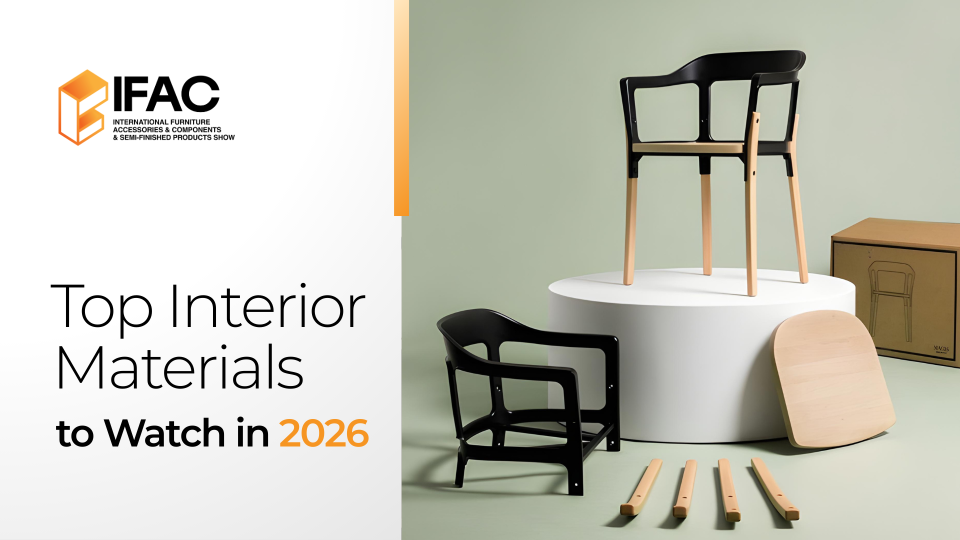
Top Interior Materials to Watch in 2026
22 August 2025
Prepared By IFAC Team
Design trends come and go — but materials define everything.
As the interior sector in MENA continues to grow rapidly, designers, manufacturers, and project developers are seeking materials that go beyond aesthetics. The 2026 interiors landscape is focused on performance, modularity, sustainability, and smart integration — and the trends emerging across IFAC editions in Dubai, Riyadh, and Cairo reflect this evolution clearly.
Here are the top material categories shaping the future of interiors — based on direct exhibitor profiles and insights from IFAC, the region’s only dedicated exhibition for furniture components, fittings, and semi-finished products.
1. Eco-Certified Panels & Core Materials
As sustainability becomes a specification standard across hospitality, residential, and public sector projects, the demand for certified and low-emission core materials is rising.
What buyers are sourcing:
- FSC/PEFC-certified MDF and particle boards
- Low-formaldehyde substrates
- Locally produced alternatives to reduce logistics impact
- Fire-retardant and moisture-resistant boards
These panels serve as the foundation for wardrobes, cabinets, and carcass structures — and are gaining attention among project developers seeking LEED-compliant materials.
2. Smart Fittings & Functional Components
Fittings are no longer secondary — they define how spaces behave.
From soft-close systems to advanced flap brakes and smart locking mechanisms, functional components are driving innovation in the way furniture is used.
Trending components in 2026:
- Height-adjustable table fittings
- Silent drawer runners
- Magnetic catches & push-to-open fittings
- Locking systems with integrated tech or security features
At IFAC, these solutions are presented not only as hardware — but as key design enablers.
3. Profiles, Trims & Edge Solutions
Subtle details make all the difference — and designers are prioritizing high-quality edge systems and profile trims that elevate the final product.
In demand:
- Decorative profile systems in black, brushed metal, or wood-look
- Soft-touch edge strips
- Coordinated trims and bars for modular systems
Whether for open shelving or minimal cabinetry, profiles are becoming visible and essential.
4. Modular & Ready-to-Assemble (RTA) Components
Speed, efficiency, and flexibility — three words defining the new production reality. Manufacturers and buyers are turning to semi-finished and modular elements that reduce production time and material waste.
Key highlights:
- Prefabricated cabinet elements
- Drawer boxes and inserts
- Postforming-ready surfaces
- Modular table and wardrobe frames
These are not only time-saving but support scalable, cross-market production and export.
5. Performance Fabrics & Upholstery Materials
Comfort meets function in today’s interior fabrics. Designers are seeking materials that offer durability, safety, and feel — especially in contract, hospitality, and office projects.
Popular fabric types:
- Anti-stain and easy-clean microfiber
- Fire-retardant upholstery foam and shaped pads
- Bonded fabrics and artificial leather
- Acoustic-enhancing textile systems
Upholstery is no longer just a soft detail — it’s a material category with serious design power.
6. Decor Papers, Films & Foils
For surface aesthetics, decor papers and functional foils continue to provide texture, depth, and affordability — without the complexity of full lamination.
Sought-after features:
- Printed woodgrains and textile patterns
- Plain color ranges in ultra-matte finishes
- Thermoformable foils and postforming elements
These materials are often paired with lightweight boards to deliver stylish, affordable interiors at scale.
7. Acoustic & Fire-Resistant Panels
With growing requirements for acoustic comfort and safety compliance — especially in corporate, public, and hospitality interiors — specialized panels are gaining momentum.
Common use cases:
- Wall coverings with integrated acoustic damping
- Sound-absorbing ceiling panels
- Fire-rated core boards for partitions and built-ins
These panels are highly technical — and designers are specifying them earlier in project timelines.
Final Thought
Today’s interior projects are defined by more than just visual appeal — they’re shaped by how materials perform, how quickly they assemble, and how responsibly they’re sourced.
As the MENA region continues its transformation, these materials are at the center of smarter, more efficient, and more resilient design.
Are you exploring any of these material trends already? Or planning to discover them at IFAC 2026?
🔗 Stay ahead. Be part of the conversation. Discover what’s shaping the next generation of interiors — only at IFAC. ifacglobal.com/book-your-stand